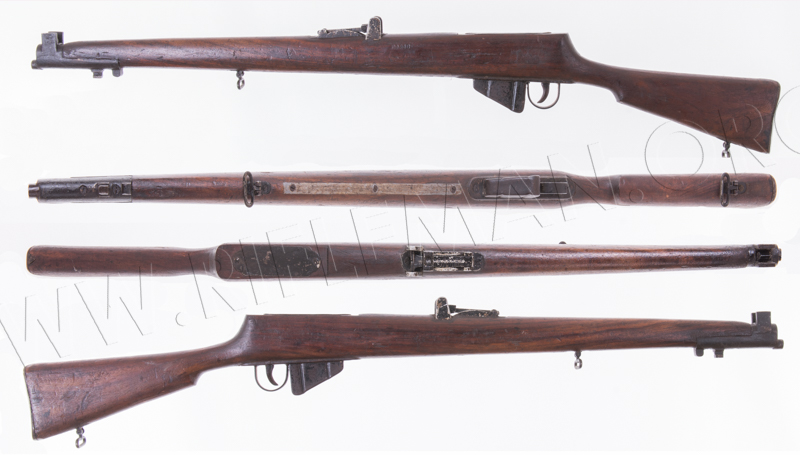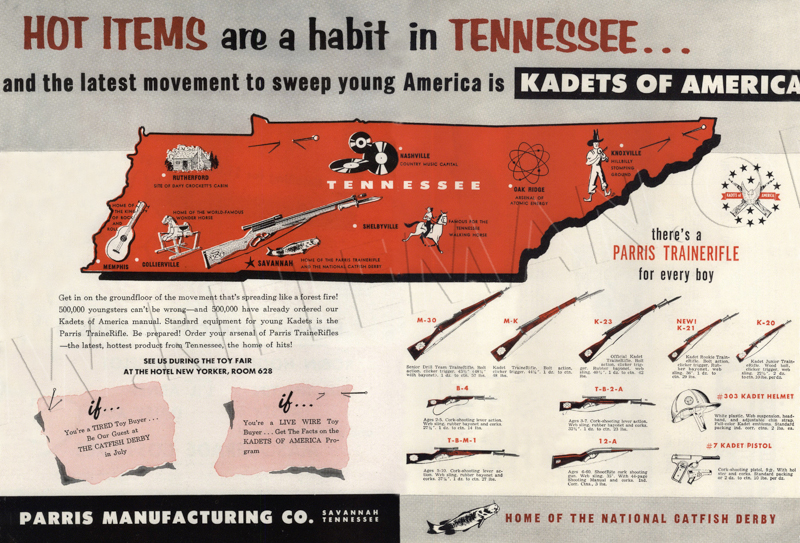DUMMY TRAINING RIFLES
See also Enfield Training Rifles of "Miniature Calibre"
A plethora of these second World War (1939-44) British dummy rifles can be found out there,
and in many different guises. Only a few were professionally manufactured, but hundreds were made by members of the Home Guard in the early days of the war when service arms were practically unobtainable for any other than active units.
A Lee-Enfield Drill and Bayonet practice rifle
Shown immediately below is a dummy training rifle of WWII vintage
and representative of the S.M.L.E. Service rifle.
Hover over or Click image to bring up hi-res file and magnifier
With a walnut-like hardwood stock, the rifle has a one-piece cast-iron
nose-cap and fore-sight, but there is a die-cast alloy rear tangent sight
with range calibrations - the leaf being spring-loaded and carrying an
elevation adjustment slider permitting aiming practice. The fabricated
steel trigger plate and magazine assembly has components brazed into a
single construction. The butt-plate, and even the sling-swivels, are of
roughly cast-iron.
Probably for simplicity, economy of manufacture, prevention of snagging in drill, and maybe for closer racking to reduce storage space, these 'rifles' were not fitted with dummy bolts.
...... and the same rifle with a Drill Purpose bayonet attached such
as might also have been used with the L59A2
DP Rifle.

Below: a close-up of the bayonet, showing the cream band around the handle denoting
the DP nomenclature

The "Fuller" groove runs clear through the point of the blade,
indicating that blade of the bayonet has been ground at the tip, reducing
its length. This was a noted modification, dependent upon the rifle model
for which its use was intended.
A number of lightweight junior training rifles were manufactured in the
U.S.A. by the Parris Dunn Corporation of Clarinda, Iowa.
To illustrate the difference between the Lee-Enfield version above, and the following U.S. cadet model, the rifles are within a half-inch of one another in overall length; the first being 44 inches, and the latter just a half inch less.
However, the former weighs 8lbs 1½ ozs, 9lbs with the bayonet; and the latter weighs in at only 3lbs 14ozs.
The latter example below is a representation of the 1903 Springfield Service
Rifle


The smaller versions of these rifles were perhaps rather more of a child's toy than a military training
rifle. The larger models were more realistic. They sold from many U.S. department stores. of the rifle illustrated, the wooden stocking even
incorporated the black-painted rear-sight, barrel "bands" and
a wooden-dowelled barrel protrusion. The 'receiver', trigger, trigger-guard
and sling-swivels were of pressed steel, but the bolt - which "actioned"
- was of cast-iron.
The steel butt-plate is impressed "VICTORY TRAINER 1942 P.D CO"
The earliest seen advertising seen to date is a
"Parris Shooting Star" pseudo newspaper of February 1953,
which was an advertising gimmick for the Savanah, Tennesee Toy Fair.
Listed were the M-20 "Small Fry" model, the M-21 "Junior Clicker", the M-22 "Clicker", the M-23 "Super", and the M-1 Cork Shooting under-lever rifle in the vein of a Winchester.
The M-23 was perhaps intended to represent the Springfield M2 training rifle
in addition to the Model 1903 full-bore service rifles.
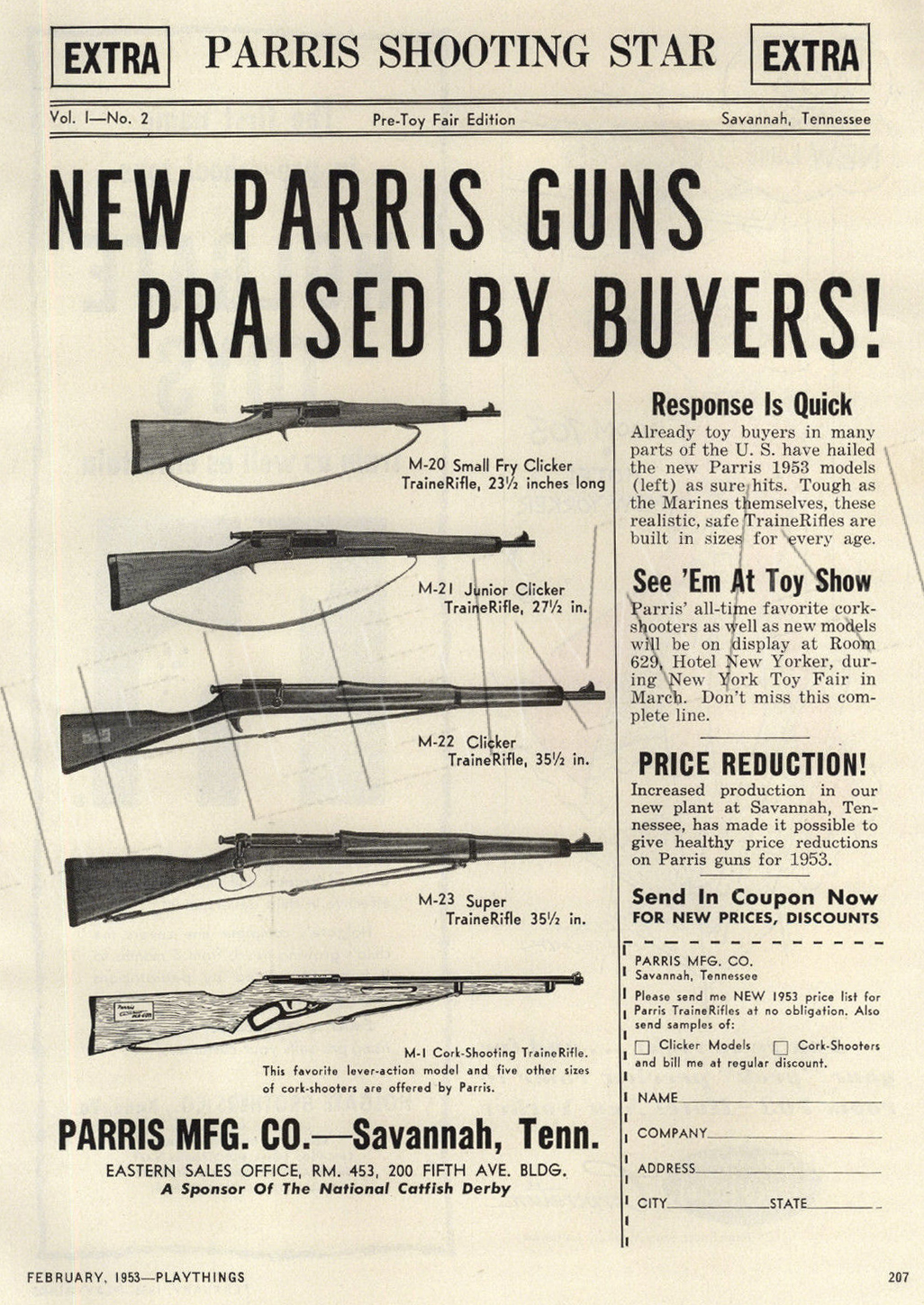
A 1955 advertisement was again issued for the annual toy fair.
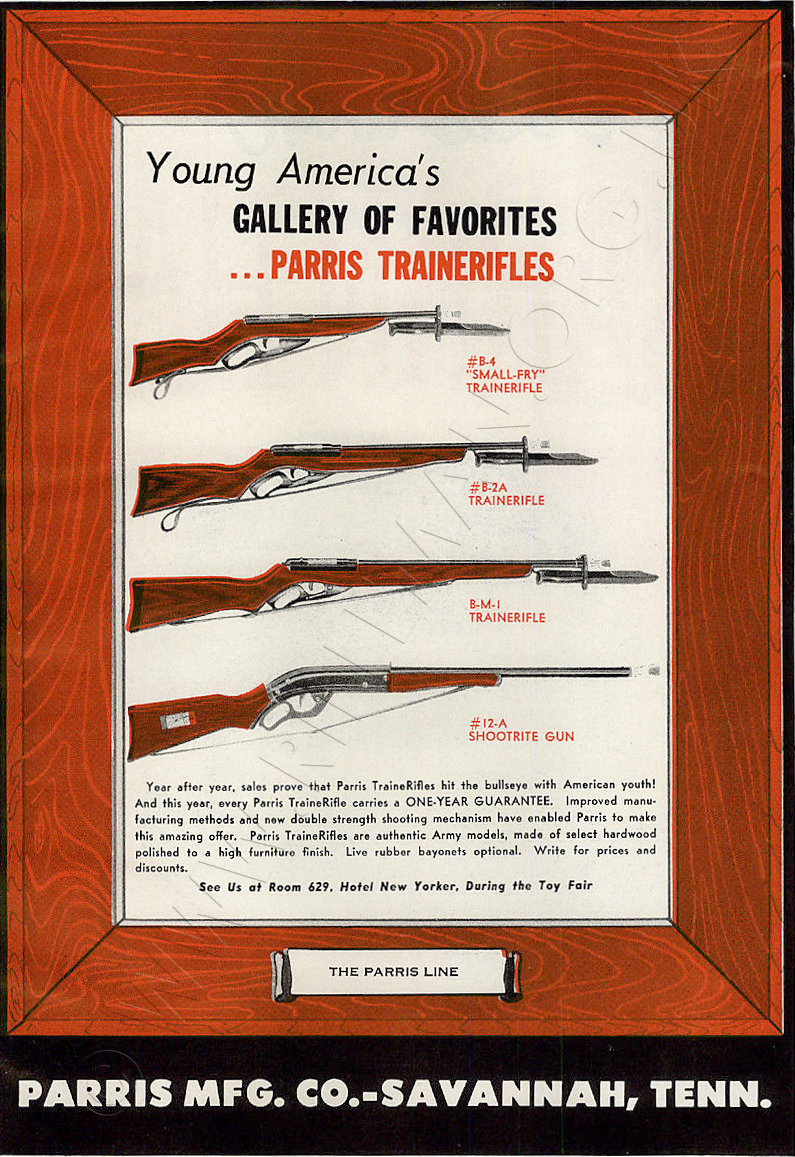
In 1956, a more detailed leaflet was published showing the then current models
Hover over or Click image to bring up hi-res file and magnifier
The intended connection with the "Kadets of America" was pointedly put.
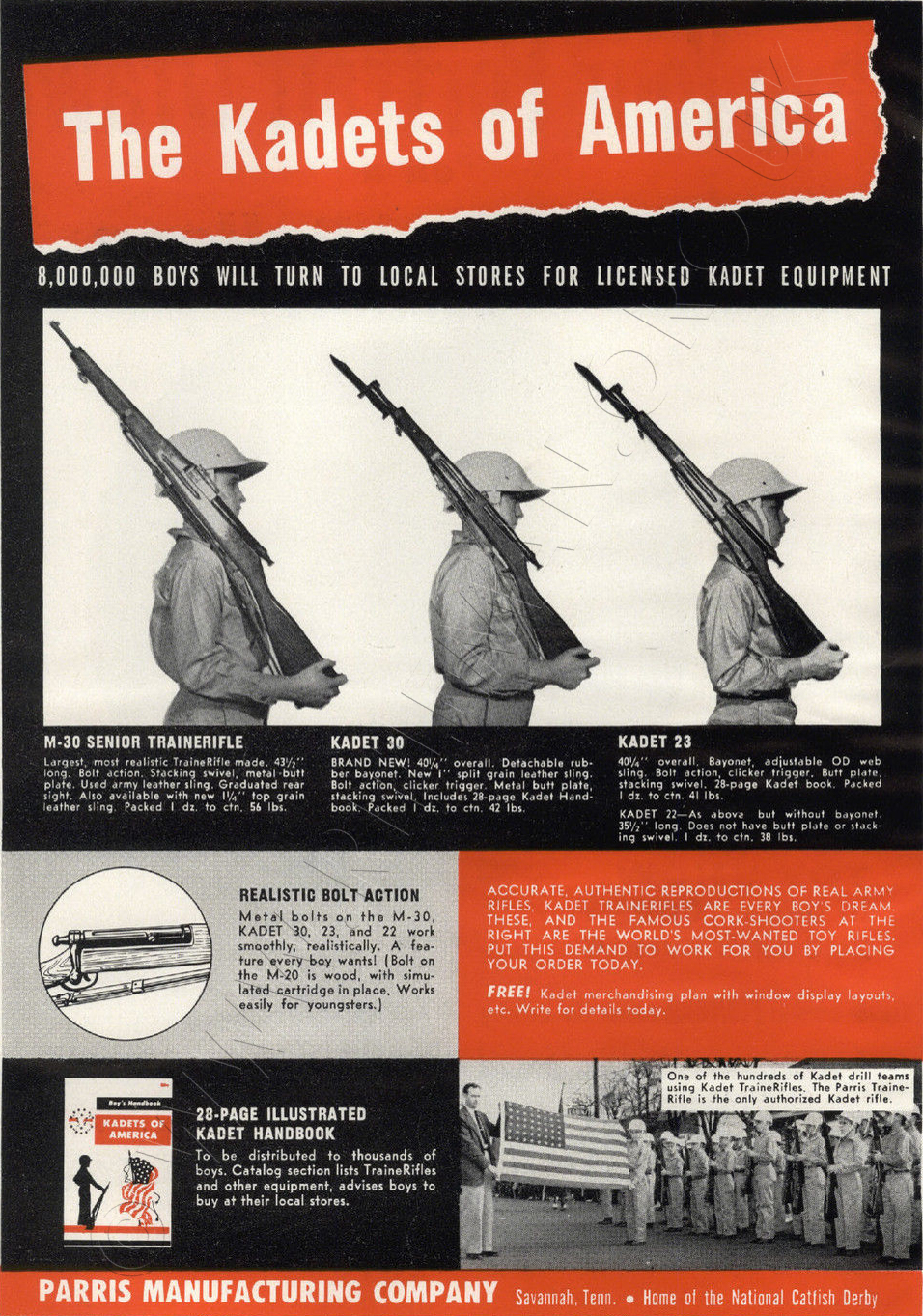
Below: a 1959 advertising purchase coupon.
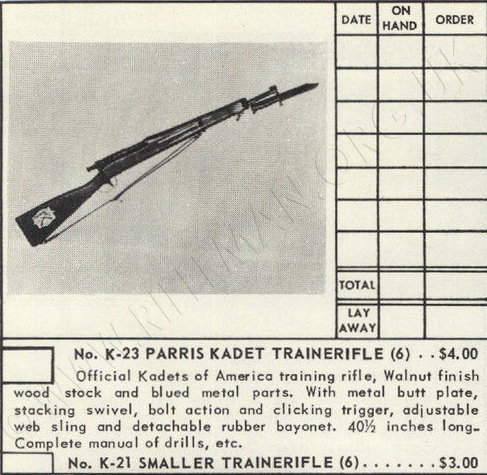
The No. K-23 "PARRIS KADET TRAINERIFLE"
is listed as the Official Kadets of America training rifle, with walnut-finish wood stock and blued metal parts. It came with a metal butt plate, stock swivel, bolt action, and a clicking trigger, adjustable web sling, and a detachable rubber bayonet.
The rifle was 40-1/2 inches in overall length.
It came with a complete drill manual at four dollars.
A smaller version, the No.K-21, was available at a a dollar less.
_____________________________________
see also the FENCING MUSKETS
_____________________________________
and click below for:
A Chronology
of Enfield genre Training Rifles, Adapters & Cartridges
the Enfield
Training Rifles of "Miniature Calibre"
A plethora of these second World War (1939-44) British dummy rifles can be found out there, and in many different guises. Only a few were professionally manufactured, but hundreds were made by members of the Home Guard in the early days of the war when service arms were practically unobtainable for any other than active units.
A Lee-Enfield Drill and Bayonet practice rifle
Shown immediately below is a dummy training rifle of WWII vintage
and representative of the S.M.L.E. Service rifle.
Hover over or Click image to bring up hi-res file and magnifier
With a walnut-like hardwood stock, the rifle has a one-piece cast-iron nose-cap and fore-sight, but there is a die-cast alloy rear tangent sight with range calibrations - the leaf being spring-loaded and carrying an elevation adjustment slider permitting aiming practice. The fabricated steel trigger plate and magazine assembly has components brazed into a single construction. The butt-plate, and even the sling-swivels, are of roughly cast-iron.
Probably for simplicity, economy of manufacture, prevention of snagging in drill, and maybe for closer racking to reduce storage space, these 'rifles' were not fitted with dummy bolts.
...... and the same rifle with a Drill Purpose bayonet attached such as might also have been used with the L59A2 DP Rifle.

Below: a close-up of the bayonet, showing the cream band around the handle denoting the DP nomenclature

The "Fuller" groove runs clear through the point of the blade, indicating that blade of the bayonet has been ground at the tip, reducing its length. This was a noted modification, dependent upon the rifle model for which its use was intended.
A number of lightweight junior training rifles were manufactured in the U.S.A. by the Parris Dunn Corporation of Clarinda, Iowa.
To illustrate the difference between the Lee-Enfield version above, and the following U.S. cadet model, the rifles are within a half-inch of one another in overall length; the first being 44 inches, and the latter just a half inch less.
However, the former weighs 8lbs 1½ ozs, 9lbs with the bayonet; and the latter weighs in at only 3lbs 14ozs.
The latter example below is a representation of the 1903 Springfield Service Rifle


The smaller versions of these rifles were perhaps rather more of a child's toy than a military training rifle. The larger models were more realistic. They sold from many U.S. department stores. of the rifle illustrated, the wooden stocking even incorporated the black-painted rear-sight, barrel "bands" and a wooden-dowelled barrel protrusion. The 'receiver', trigger, trigger-guard and sling-swivels were of pressed steel, but the bolt - which "actioned" - was of cast-iron.
The steel butt-plate is impressed "VICTORY TRAINER 1942 P.D CO"
The earliest seen advertising seen to date is a
"Parris Shooting Star" pseudo newspaper of February 1953,
which was an advertising gimmick for the Savanah, Tennesee Toy Fair.
Listed were the M-20 "Small Fry" model, the M-21 "Junior Clicker", the M-22 "Clicker", the M-23 "Super", and the M-1 Cork Shooting under-lever rifle in the vein of a Winchester.
The M-23 was perhaps intended to represent the Springfield M2 training rifle
in addition to the Model 1903 full-bore service rifles.

A 1955 advertisement was again issued for the annual toy fair.

In 1956, a more detailed leaflet was published showing the then current models
Hover over or Click image to bring up hi-res file and magnifier
The intended connection with the "Kadets of America" was pointedly put.

Below: a 1959 advertising purchase coupon.

The No. K-23 "PARRIS KADET TRAINERIFLE"
is listed as the Official Kadets of America training rifle, with walnut-finish wood stock and blued metal parts. It came with a metal butt plate, stock swivel, bolt action, and a clicking trigger, adjustable web sling, and a detachable rubber bayonet.
The rifle was 40-1/2 inches in overall length.
It came with a complete drill manual at four dollars.
A smaller version, the No.K-21, was available at a a dollar less.
_____________________________________
see also the FENCING MUSKETS
_____________________________________
and click below for:
A Chronology of Enfield genre Training Rifles, Adapters & Cartridges
the Enfield Training Rifles of "Miniature Calibre"
Dummy_training_rifles
Notes (taken from eBay auction of rubber bayonet) for use in detailing Parris when page updated,
not intended for publication on website.
This is an authentic stiff black rubber bayonet that fit the dummy US Springfield
1903 Rifle used to train Marines. Measures 8 inches long and is in excellent
condition with no splits or tears. Handle is marked Parris Training Rifle Savannah
Tennessee. I will show a picture of the rifle that it fit in the auction but
the auction only includes the knife. Someone else owns the rifle shown. I believe
these training rifles were named after Parris Island.
Marine Corps Recruit Depot Parris Island
Marine Corps Recruit Depot Parris Island is an 8,095 acre (32.9 km²) military installation near Beaufort, South Carolina (32°19'44"N, 80°41'41"W) tasked with the training of enlisted Marines. Male recruits living east of the Mississippi River and female recruits from all over the USA report here to receive their initial training. (Male recruits living west of the Mississippi River receive their training at Marine Corps Recruit Depot, San Diego, California).
Early History
A French Huguenot expedition, led by Jean Ribault in 1562, was the first European group to attempt to colonize Parris Island. Earlier Spanish expeditions had sighted the area, and named it "La Punta de Santa Elena", which now remains one of the oldest continuously used European place names in the United States. The French expedition built an outpost named Charlesfort, and Ribault left a small garrision as he returned to France for colonists and supplies. After a long absence, due to Ribault's delay from wars in Europe, Charlesfort was abandoned after the garrision mutinied, built a ship on the island, and sailed back to France in April 1563. In 1566 the Spanish, led by Pedro Menéndez de Avilés founded a settlement named Santa Elena which became the capital of La Florida for the next decade. Santa Elena was finally abandoned by Spain in 1587. England took control of the region by the 17th century, and Parris Island became home to British plantations after being purchased by Colonel Alexander Parris, treasurer of the South Carolina colony, in 1715. From the 1720s to the Civil War, the island was divided into a number of plantations, initially growing indigo, then later cotton. During and after the Civil War, the island was home to freed slaves, and was a site of freedmen schools taught by abolitionists such as Frances Gage and Clara Barton.
Port Royal Sound was captured by Union Forces in 1861, and Parris Island became a coaling station for the Navy. This function was taken up again after the war, thanks in large part to the former slave turned Congressman Robert Smalls, who fought for the creation of a new federal military installation on the island.
History of the Depot
Marines were first stationed on Parris Island in 1891, in the form of a small security detachment headed by First Sergeant Richard Donovan. His unit was attached to the Naval Station, Port Royal, the forerunner of Parris Island. Donovan's unit was highly commended for preserving life and property during hurricanes and tidal waves that swept over the island in 1891 and 1893.
Military buildings and homes that were constructed between 1891 and World War I form the nucleus of the Parris Island Historic District. At the district center are the commanding general's home, a 19th century wooden dry dock and a turn of the century gazebo — all of which are on the National Register of Historic Places.
On November 1, 1915, Parris Island was officially designated a Marine Corps Recruit Depot and training was continued from then on.
Prior to 1929, all transportation to and from the island was by ferry from Port Royal docks to the Recruit Depot docks. In that year the causeway and a bridge over Archer's Creek were completed, thus ending the water transportation era. The causeway was dedicated as the General E. A. Pollock Memorial Causeway in April 1984. During the fateful December of 1941, 5,272 recruits arrived there with 9,206 arriving the following month, making it necessary to add the 5th, 6th, 7th and 8th Recruit Training Battalions. As the war influx continued, five battalions were sent to New River, North Carolina to train, and the Depot expanded to 13 battalions.
From 1941 through 1945, 204,509 recruits were trained here. At the time of the Japanese surrender, more than 20,000 recruits were aboard the Depot.
On February 15, 1949, a separate "command" was activated for the sole purpose of training female Marine recruits. This command has since been designated the 4th Recruit Training Battalion and is the only battalion in the Corps for training female recruits.
The Korean conflict began in 1950 when 2,350 recruits were in training. From then until the 1st Marine Division was withdrawn from Korea, Parris Island drill instructors trained more than 138,000 recruits. During March 1952, the peak training load of 24,424 recruits was reached.
The recruit tide again flooded during the years of the Vietnam War. A peak training load of 10,979 was reached during March 1966.
Today about 17,000 recruits are trained at Parris Island each year.
Recruit training
Initial training for those enlisted in the United States Marine Corps, also referred to as boot camp, is a thirteen week process during which the recruit is cut off from the civilian world and has to adapt to a Marine Corps lifestyle. During training, recruits are trained in a wide variety of subjects including weapons training, Marine Corps Martial Arts Training, personal hygiene and cleanliness, sexually transmitted diseases, formation drilling, and Marine Corps history. Physical fitness is strongly emphasized during training and recruits must meet a minimum standard of fitness to graduate. A three-mile run, pull-ups, push-ups, and crunches are tested as part of the so-called PFT (Physical Fitness Test). Recruits must also meet minimum combat-oriented swimming qualifications, qualify in rifle marksmanship with the M16A2 service rifle, and pass a 54-hour simulated combat exercise known as "The Crucible".
Stress is constantly applied by drill instructors to teach recruits how to work under pressure. This may be pivotal later on in combat situations. Recruits are yelled at constantly, and forced to do simple tasks over and over again, which is supposed to instill teamwork and leadership traits and is in no way to be taken personally by the recruit. Only by passing the rigors of boot camp can one earn the title "United States Marine".
The Marine Corps and Navy are the only branches of the military whose basic training is officially called "boot camp". The Marine Corps basic training (boot camp) is the longest of all military branches at 12 weeks of actual training, and 1 week of "Receiving" for a total of 13 weeks spent on the island. Only in the Marine Corps is each recruit required to qualify at 500 yards on the rifle range.
References in Popular Culture
* Parris Island is mentioned in Billy Joel's song "Goodnight Saigon" from The Nylon Curtain.
* Parris Island is mentioned in the Street Dogs song "Final Transmission" from the album Fading American Dream.
* Parris Island is depicted most famously in Stanley Kubrick's movie Full Metal Jacket, with R. Lee Ermey as a memorable drill instructor.
* Depicted in the more conventional film The D.I., directed by and starring Jack Webb.
Return to: TOP of PAGE
See this website's Raison d'être
